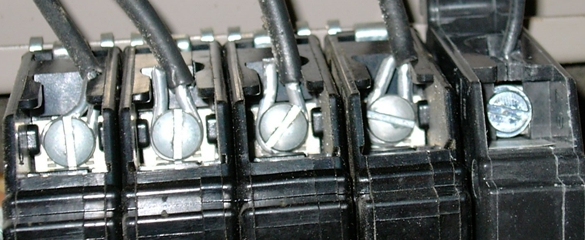Massachusetts Home Inspections YOUR INVESTMENT IS MY CONCERN

Aluminum Branch Wiring - Upgrading

| DESCRIPTION | RESULTS | COSTS | |
| REWIRE | Replace all aluminum solid wire with copper wire. | The best and most permanent solution, though expensive, is strongly recommended. | Highest |
| PIGTAIL | Eliminates the aluminum wire connection to switches and outlets by splicing in a short length of copper wire. | Replaces the aluminum connection at the receptacle (or switch) terminals with a more reliable splice. |
Moderate
|
| REPLACE | If the outlets and switches are old or not marked with "CO/ALR," have them replaced. | Significantly reduces the most common failures, though less permanent than rewiring your entire house. | Low |
| LEAVE IT ALONE | If the load test is satisfactory and no signs of issues are found, repairs can be postponed. However, periodic load testing by a licensed electrician is recommended. | Consider this option as a way to buy (or borrow) time. It is not recommended as a long-term solution. | Lowest |
REWIRING THE ENTIRE HOUSE
The definitive solution to aluminum wiring concerns is to remove it entirely. New copper branch wiring can be installed, leaving the old aluminum wiring abandoned within the wall cavities. The cost and disruption of this process depend largely on the construction of the house. If the home has a wide-open, unfinished crawl space, basement, or attic, the rewiring job will be much easier. In many cases, the cost may not be significantly higher than other "partial" solutions mentioned earlier. If you're considering remodeling, either in full or in part, it's a good idea to replace any aluminum wiring in that area. Additionally, consider upgrading or replacing the service entrance cable at the same time, as it’s likely 30 to 40 years old and may be undersized by today’s standards.
PIGTAIL THE RECEPTACLES
It is possible to completely avoid the issue of aluminum wiring connecting to your outlets and switches. This can be done by having a licensed electrician crimp a short length of copper wire to the aluminum wire using a connection known as a "PIGTAIL". A pigtail crimp eliminates the aluminum connection at your switches and outlets, as all aluminum connections will be permanently pigtailed with copper wiring. The CPSC does not recognize any other system or correction as acceptable, which raises legal concerns for anyone recommending an alternative solution.
Pigtail crimps cannot be installed by the average homeowner. TYCO Electronics does not sell the AMP crimping tool; they hold patents pending and only allow users to lease the equipment. This limits access for residential or small-scale work, as it is difficult to justify the leasing costs for just one house. Furthermore, the number of "qualified" electricians who have completed the AMP training is limited, with most of them being commercial electricians. As a result, there are very few electricians nationwide who are qualified to perform this work. Given this situation, I, as your home inspector, cannot recommend this as a solution, as most clients will not be able to find a qualified electrician in their area. My approach is to explain the aluminum wiring issue so that clients understand the concerns and then recommend they consult a licensed electrician to determine the best course of action.
REPLACE OUTLETS AND SWITCHES
In the past, copper wiring was the standard, and outlets and switches were not marked to indicate compatibility with specific wire types. When aluminum wire was introduced, it was installed the same way as copper wire, but problems soon emerged with deteriorating connections. To address this, new alloys were used in wiring devices, and these devices were marked as CU-AL or AL-CU. However, it was later discovered that smaller sizes of aluminum wire continued to cause issues, leading to the development of better equipment for small branch circuits, which was labeled CO/ALR. Today, CO/ALR is the only acceptable marking for outlets and switches in small branch circuits.
Many homes still have the original wiring devices, which are likely marked CU-AL or may not be marked at all. These devices are also aging, which can result in issues such as receptacles struggling to grip plugs and switches failing. Replacing these outdated wiring devices is the minimum necessary upgrade to make aluminum wiring safe. It's important to minimize bending and handling of the wire, clean off any oxidation at each connection, and apply anti-corrosion paste. This is not a do-it-yourself project when aluminum wire is involved; it should be handled by a licensed professional.
LEAVE IT ALONE
If you're looking to delay repairs for a while, have an electrician perform a load test on the wiring, and repeat the process annually. Keep detailed records. If the voltage drop on a circuit (or across all circuits) begins to increase, it signals an impending failure. If you have the aptitude and equipment, you can perform this test yourself as often as you like. Aluminum wiring in good condition is better left undisturbed. Load testing and inspecting the devices for the CO/ALR marking can be done without disturbing the wiring. Consider this option as a temporary solution, postponing the inevitable.
CHECK ALL CONNECTIONS
Regardless of the method you choose for addressing outlets and switches, the aluminum connections in the circuit breaker panel, as well as at all junction boxes and receptacles, should be inspected by a licensed electrician. At the circuit breaker panel, ensure that each aluminum wire is coated with a corrosion inhibitor. Have your electrician apply the specified torque to each screw terminal to ensure it hasn’t loosened over time. When re-making a connection, remember to abrade the wire to remove the aluminum oxide layer and immediately apply additional corrosion inhibitor before reconnecting any aluminum wire.
Locate all junction boxes (outlets and switches) and inspect the connections. All connections should be re-done using one of the approved splicing methods described above, though care should be taken to avoid excessive handling of the wire. Be sure to read the manufacturer's instructions to ensure the proper splicing method is used.
Here is what my clients have to say about my home inspection services:
Press F5 (on your keyboard) for additional testimonials
Hi David,
I just wanted to send you a quick note to thank you again for your help yesterday!!
Andy and I are very appreciative of all of the information you provided us with, and we both feel that we have an excellent understanding of what needs to be done to this home, and can make our decision with assurance. The tips that you provided us with are invaluable, and I will definitely recommend you to anyone I know that is or will be buying a home.
Thank you again!
Alyssa














